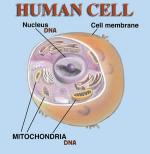|
This section contains 746 words (approx. 3 pages at 300 words per page) |

|
A cell is the basic unit of life—the smallest part of living organisms capable of surviving independently and reproducing itself. Every living organism is made of cells, but the size and shape of the cells varies according to their function. All cells, however, have the same basic structure. The protoplasm--the living substance that makes up the cell--consists of two main parts: the nucleus and the cytoplasm.
The nucleus is a round body near the center of the cell that contains the hereditary material determining the cell's structure and activities. This material, called chromatin, ordinarily looks like a ball of tangled string, but begins to turn into rodlike chromosomes during cell division. These chromosomes contain packages of DNA (deoxyribonucleic acid) information, which essentially acts as a blueprint for the human body. The cell nucleus also contains nucleoli, which contain proteins and RNA (ribonucleic acid).
The cytoplasm is...
|
This section contains 746 words (approx. 3 pages at 300 words per page) |

|


